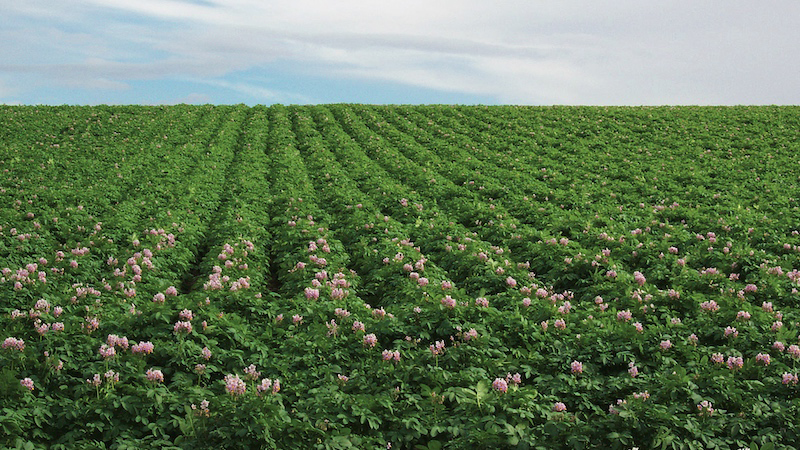The State Of Mechanical Apple Harvesting
The era of fully automated robotic harvesters navigating orchard rows is still years away. But as we head into the 2015 season, there have been some really impressive developments in orchard mechanization, some of which are available to growers this season.
Rather than wait for robots, these systems make the best use of a combination of people and equipment that can do the job efficiently and relatively cost effectively. Developers have approached the challenge from different angles, but each is focusing on improved harvest efficiency, reduced picker fatigue, and minimal fruit bruising.
The Vacuum Harvester
You’ve been hearing about it for a few years now, but the Vacuum Harvester from DBR Conveyor Concepts may well be seen in its first commercial orchards this season. The unit is comprised of two parts: the self-propelled Brownie Quad platform, and the vacuum harvesting unit. A crew of four pickers man the hydraulic platform picking fruit from trees up to 13-14 feet.
Pickers carefully place each apple into a receptacle attached to a foam-lined vacuum tube, which whisks the fruit away at 12 feet per second. As it nears the end of the vacuum tube, deceleration wheels with foam-lined pockets slow the apple down and gently place it on a distributor wheel that settles the fruit, bruise-free, in the bin.
The ability to nearly eliminate bruising is a big selling point, says Phil Brown, owner of Phil Brown Welding and one of the designers of the unit.
“If you’re picking with a picking bucket you’re putting apples on apples, then you go over and dump apples on apples in the bin,” he says. “With this machine, the person picks the apple and puts it in the bucket inlet to the tube, and once he drops it in there, no apple touches another apple all the way to the bin.”
Brown claims the unit can handle up to twice the volume of other machines.
“We can get a bin every nine minutes, plus a minute for bin change. That’s with four pickers, plus one person doing quality control and doing the bin swap. If we figure all five people as the crew, we’re picking about 24 bushels per man hour,” he says.
Replacing the traditional method of having pickers fill buckets and dumping those in bins also saves time and reduces picker fatigue, Brown says.
“It’s going to take roughly 10 seconds on average to empty that bucket each time. And they have to do that 30 times for each bin. By eliminating that, we can take maybe seven or eight minutes out of their pick time. And with our machine, they pick steady for 10 minutes but then have 45 seconds to a minute break when we swap bins. That gives them a second to relax and it all helps on fatigue. They can pick all day and they don’t get tired,” he says.
Brown suggests a first pass through on foot to get low fruit, followed by the harvester to pick the crop higher in the trees.
“Just picking the tops of the trees, we can cover 200-plus acres in a season with one machine,” he says.
The full machine with the Brownie Quad platform and the harvester lists at $126,500. Some growers may already own the platform (which has been available for a few seasons) to use for pruning and thinning. In that case, the cost of adding the vacuum harvester would be $79,000.
Brown says he believes the increased productivity the unit will provide makes the return on investment reasonable.
“I think anybody with 75 acres or more is going to pay for the machine pretty quick, probably three to four years. If they’re just buying the platform for trellises and pruning, that will have a shorter payback, because they can use it all year,” he says.
Pluk-O-Trak
A related concept that combines people and labor-saving automation is Munckhof’s Pluk-O-Trak harvester, available in the U.S. from OESCO. The Pluk-O-Trak combines hydraulic platforms (which can be reconfigured for pruning, hand thinning, and trellis maintenance) with a series of conveyors that deliver apples to the bins.
Pickers, both on the platform and on the ground, place the fruit on fingered conveyor belts that carry it to a rotating bin filler. Once the picker places an apple on the conveyor, it doesn’t touch another apple until it reaches the bin, reducing bruising. According to the company, fruit quality is increased by 50% to 60% compared to conventional harvesting methods.
By combining pickers on the platforms and on the ground, harvest can be done in a single pass through the row, says OESCO sales representative Andrew Dulude.
“A crew of six to eight can fill six to seven bins per hour, and without ladders and buckets, there’s a lot less picker fatigue,” he says.
The Pluk-O-Trak lists for $78,400. “In our experience, growers with at least 22 acres of proper plantings can use the unit cost-effectively,” Dulude says.
Low-Cost Harvest Platform
While units like the Vacuum Harvester and the Pluk-O-Track are designed for larger acreages, there’s a serious need for automation in orchards of all sizes. Paul Heinemann, professor of agricultural and biological engineering at Penn State University, is doing work on a low-cost harvest-assist device that fits the budgets of smaller growers. Like the bigger units, Heinemann’s work is trying to bridge that gap between fully manual and fully automated harvesting. His research focuses on a system that can be adapted to affordable, two-person, self-propelled platforms.
“We want this unit to really be platform independent if possible, so growers can adapt equipment they might already have. Our target is a system that costs the grower less than $10,000,” he says.
Penn State Ph.D. student Zhao Zhang is refining a prototype that uses gravity to feed apples from the picker through tubes to a bin with minimal bruising. Tests are continuing this year, with an eye to finding a commercial partner to help get the unit into the hands of growers. Tests with Fuji have been promising, Heinemann says.
“Even a relatively simple system like this is more efficient for most growers because pickers aren’t carrying ladders and spending time climbing up and down. Compared to those practices, this device will help reduce bruising and enhance efficiency and ergonomics for the pickers,” he says.
The Robots Are Coming
All this is not to say robotics aren’t still the future, at least for bigger growers. Penn State University professor of ag economics Jayson Harper is part of a team focused on bringing robotic pruners to vineyards, and perhaps eventually, to orchards.
Developments in the video game industry have helped bring the cost of robotic arms and sensors way down in the last decade. Those advances are helping the team’s work with a company called Vision Robotics on an autonomous grapevine pruning system.
With the system they’re working on, a tractor drives slowly down a row — about 8 feet per minute — and using a vision system, a computer algorithm makes decisions on where the unit’s two robotic arms will make pruning cuts. Using the system 16 weeks a year, Harper estimates a grower, or a custom service, could prune about 155 acres of grapevines with a single unit.
“Grapevines are essentially a two-dimensional surface for pruning. We’re not many years away from that. Apple trees are much more complicated. It will be harder, but not impossible, to develop an autonomous pruner for tree fruit,” he says.
Washington State University assistant professor Manoj Karkee is part of another team working on robotics, but with a bit of human-machine collaboration.
“We’re working on techniques where people can help the robotics a little to make the technology more adaptable and affordable,” Kankee says.
For example, work is being done with vision systems that can target and pick apples, but human operators might step in to help identify the last 1-2% of fruit that’s somewhat hidden and difficult for the machines to find. Work is also being done to study and understand how human pickers do tasks now so that robotic pickers might be able to mimic them.
Other research Kankee and his fellow team members are working on includes:
• A shake and catch system that shakes only a targeted area in the canopy and catches the fruit directly beneath to reduce damage caused by long falls or contact with branches or other fruit.
• A cropload estimation tool that uses machine vision to count and size every piece of fruit on a tree and provide a substantially improved estimate of crop size.
• The use of unmanned aerial vehicles, or UAVs, as bird deterrents in cherry, blueberry, and grape crops.
“Some of this has been investigated in the past but we’re trying to refine that work. I am confident we will see equipment in the field in the next five to 10 years,” Kankee says. “I really believe it will work, and with the challenges growers face, it really must work.”










